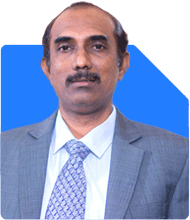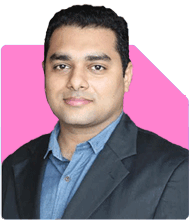Ramalingam Kalirajan |10870 Answers |Ask -Follow
Mutual Funds, Financial Planning Expert - Answered on Jul 28, 2025
He has an MBA in finance from the University of Madras and is a certified financial planner.
He is the director and chief financial planner at Holistic Investment, a Chennai-based firm that offers financial planning and wealth management advice.... more

Hello Sir , Im retired at the age of 50 and I am a new entrant in mutual funds. I have invested the following towards liquidity and capital appreciation . 1) Chola Perpetual Bonds 50 Lac @ 8.9 % , 2) Shriram FD 30 Lacs for 36 months @8.30%, ICICI Prudential Multi Asset Fund 75 lacs Regular Growth, 3) Parag Parikh Flexi Cap Equity Fund 32 lacs Regular Growth, 4) HDFC Flexi Cap equity Fund 33 lacs Regular Growth, 5) ICICI Prudential India Opportunities Fund 17 lacs Regular Growth, 6) HDFC Asset Allocation FOF Regular Growth 50 Lacs. My objective was capital appreciation and fixed income of 2. 5 Lacs monthly. I am doing all these investments under regular growth with a financial adviser . Total investments as of date is 2.8 Cr, the investments started in May 2025. I have committed to investing a total of 7.5 Cr out of which 2.8 cr is already invested In the pipeline are 1) ICICI Balanced Advantage Fund 50 Lacs, 2) Kotak Balanced Advantage Fund 50 lacs which I aim to invest in August 2025 This makes it a total investment of 3.8 CR. The remaining 3.7 Cr will be used to top up the mutual funds already invested in Since Im a new entrant , the only fund that Im seeing giving me good returns since start is the ICICI Multi Asset Fund. The remaining equity funds are all in the negative . Now the question is , am I on the right track ? moreso my next tranche of topups / investments should be done where. Im not confident of equities though I was warned of volatility. The plan for August is : 1) 50 Lacs each in ICICI & Kotak BAF's, 2) 33 Lacs in HDFC Flexi Cap Fund, 3) 32 Lacs in Parag Pariks Flexi Fund, 3) 17 Lacs in ICICI Opportunities fund, 4) 18 Lacs in HDFC Multi Asset FOF The same investment cycle as August will be done in Sep 2025 with the exception of HDFC FOF & BAF as its yet to be decided Kindly advise if Im on the right path. Moreso I am seeing very high expense ratio with most of the funds . Please also advise as to when I should start the SWP from the Balanced Advantage funds once invested Thanks
? Investment Strategy Assessment
– Your split between fixed income (Chola bonds, Shriram FD) and mutual funds shows balance.
– Rs. 80 lakh in fixed income at above 8% yields nearly Rs. 6.5 lakh/year. That covers around Rs. 54K/month. It's a good start.
– Rs. 2 crore already in growth-oriented mutual funds shows intent for long-term appreciation.
– You’ve chosen asset allocation, flexi cap, multi-asset, and opportunities-oriented funds. This adds good diversification.
– The plan to further deploy Rs. 4.7 crore into balanced and existing funds spreads risk and potential return across market cycles.
– The monthly withdrawal target of Rs. 2.5 lakh from a Rs. 7.5 crore portfolio (around 4% yearly) is sustainable if well structured.
– Your use of regular growth plans via an MFD is wise. The MFD ensures service, portfolio rebalancing, and psychological support during volatility.
? Volatility in Equity Funds – Is This Normal?
– Equity funds may show red in early months. This is entirely normal.
– Markets may stay sideways or even decline short-term. But with time, they grow with the economy.
– Multi-Asset and Balanced Advantage Funds (BAFs) tend to perform better in early phases due to equity-debt balancing.
– The fact that ICICI Multi Asset is giving you early comfort is due to its hybrid nature. That doesn’t mean the equity funds are flawed.
– Give your pure equity funds like Flexi Cap and Opportunities Fund at least 3–5 years to reflect true performance.
– Avoid judging fund quality based on short-term NAV.
? Expense Ratio Concern – Regular vs. Direct
– Regular funds come with MFD services. This is your financial partner’s time, insights, and effort.
– Direct funds save expense ratio but you lose handholding, periodic review, and strategy updates.
– Especially for a retiree, making mistakes due to inexperience or emotions can cost more than expense ratio savings.
– As a new investor, regular plans through a Certified Financial Planner offer better outcomes and peace of mind.
– Expense ratio in regular plans is a small price for personalised advice, service, and continuity.
? Your August and September Investment Plan – Is It Right?
– Your August investments of Rs. 1.5 crore into two BAFs and topping up Flexi Cap, Multi Asset, and Opportunities fund is well thought out.
– BAFs bring downside protection and rebalancing. They are apt to begin Systematic Withdrawal Plan (SWP) from.
– Flexi Cap topping helps long-term equity growth. Parag Parikh and HDFC Flexi Cap are quality options.
– Topping up the Multi Asset and Opportunities fund is also suitable. You already have partial experience with them.
– September tranche repeating the August structure is a fine idea—consistency reduces timing risk.
– However, skipping HDFC Asset Allocation FOF and BAF in September, if not finalised, is acceptable. You can revisit based on August NAV movements.
? Suggestions Before You Top Up Further
– Do not top up based on short-term performance.
– Stay with current schemes unless the fund’s fundamentals change.
– Confirm asset allocation remains balanced after top-ups. Keep equity:debt within your comfort zone.
– If equity exposure crosses 65–70%, and you are uncomfortable, pause and reconsider future top-ups.
– Do not make emotional decisions based on red NAVs in first 3–6 months.
– Ask your CFP to run stress-test scenarios before every tranche deployment. This helps maintain confidence.
? SWP Strategy – When and How to Start?
– SWP should be started only once at least Rs. 1–1.5 crore is in Balanced Advantage Funds.
– Let these funds remain invested for 2–3 months minimum post-purchase. This allows the fund to settle in terms of market exposure.
– Ideally, start SWP from November or December 2025 if funds are deployed in August.
– Begin with Rs. 1 lakh/month from BAFs initially. You can scale to Rs. 2.5 lakh later as the corpus grows.
– SWP from equity-oriented BAFs is tax-efficient. Gains will be taxed at only 12.5% LTCG beyond Rs. 1.25 lakh annually (as per July 2025 rule).
– Keep a 12-month contingency in liquid form or FD for emergencies or SWP delays.
? Diversification Review – Any Gaps?
– You have spread across Flexi Cap, Multi Asset, Opportunities, Asset Allocation FOF, and BAFs. This is healthy.
– Exposure to different AMCs is balanced. You're not over-concentrated in one fund house.
– Chola bonds and Shriram FD give non-market linked income. This cushions equity volatility.
– You may want to keep Rs. 20–25 lakh in high-liquidity products like Liquid Funds or Ultra Short-Term debt funds. This supports any sudden need.
– Avoid taking more than 50% of your entire corpus into high-risk equity funds even if markets rise.
– It is not necessary to chase the “best” fund always. Staying consistent with well-rated, diversified funds is smarter.
? Tax Planning Outlook
– Ensure you and your spouse’s PAN are optimally used while redeeming to avoid excess LTCG in one name.
– Spread withdrawals from equity to stay below Rs. 1.25 lakh LTCG limit per person, per year.
– Your fixed income (FD + Bonds) will be taxed as per slab. You may consider holding some in your spouse’s name if she is in a lower slab.
– Capital gains from mutual funds should be reviewed yearly. Don't wait till March to do last-minute tax planning.
– Avoid frequent switching between funds—it may lead to short-term capital gains at 20% tax rate.
? Emotional Comfort and Behavioural Aspects
– It’s very normal to feel anxious seeing funds in negative returns.
– Behavioural discipline is as important as fund selection.
– Your decision to go via MFD route ensures you have someone to speak to when emotions rise.
– Avoid panic-driven exits. Equity markets work only with time and patience.
– Don't track NAV daily or weekly. Track portfolio only once a month.
– Communicate clearly with your CFP. Share discomforts before acting.
? Expense Management from Investment Income
– Rs. 2.5 lakh/month goal is reasonable for a Rs. 7.5 crore corpus. That’s only 4% annual withdrawal rate.
– BAFs and Multi Asset Funds are ideal to start SWP from.
– Use Fixed Deposit and Bond income to supplement SWP in the first few years.
– Let equity-only funds grow undisturbed for at least 5–7 years.
– If market dips, use FD interest or liquid corpus to avoid redeeming equity funds at low NAV.
– Review the portfolio with your CFP every 6 months. Adjust only if goals or markets shift sharply.
? What Not To Do
– Don’t judge a fund within 3–6 months. Growth funds take time.
– Don’t go for direct funds. The support from an MFD with CFP credentials adds value far beyond the small expense savings.
– Don’t chase star performers or sectoral trends. Stay with diversified strategies.
– Don’t get tempted by structured products or PMS at this stage. Stick to mutual funds for transparency and liquidity.
– Don’t ignore liquidity. Keep at least 6–12 months’ expenses in a liquid fund or FD.
– Don’t skip reviewing tax angles. Annual rebalancing may have capital gain impacts.
? Finally
– You are on the right path. A Rs. 7.5 crore plan with Rs. 2.5 lakh income goal is sustainable.
– Fund selection is broadly appropriate for both growth and safety.
– Follow through your investment tranches without panic.
– Avoid direct funds or expense ratio worries. Focus on outcome, not cost.
– With disciplined SWP, professional handholding, and patience, your plan will deliver.
– Stay connected with your MFD-CFP for regular review and emotional guardrails.
– Your early retirement is not just achievable but potentially inspiring if implemented with this consistency.
Best Regards,
K. Ramalingam, MBA, CFP,
Chief Financial Planner,
www.holisticinvestment.in
https://www.youtube.com/@HolisticInvestment
Best Regards,
K. Ramalingam, MBA, CFP,
Chief Financial Planner,
www.holisticinvestment.in
https://www.youtube.com/@HolisticInvestment
You may like to see similar questions and answers below
Ramalingam Kalirajan |10870 Answers |Ask -Follow
Mutual Funds, Financial Planning Expert - Answered on May 07, 2024
Ramalingam Kalirajan |10870 Answers |Ask -Follow
Mutual Funds, Financial Planning Expert - Answered on May 21, 2024
Ulhas Joshi |280 Answers |Ask -Follow
Mutual Fund Expert - Answered on Aug 13, 2024
Milind Vadjikar | Answer |Ask -Follow
Insurance, Stocks, MF, PF Expert - Answered on Nov 26, 2024
Ramalingam Kalirajan |10870 Answers |Ask -Follow
Mutual Funds, Financial Planning Expert - Answered on Apr 23, 2025
Dr Dipankar Dutta |1837 Answers |Ask -Follow
Tech Careers and Skill Development Expert - Answered on Dec 05, 2025
Dr Shyam Jamalabad |108 Answers |Ask -Follow
Dentist - Answered on Dec 05, 2025
Dr Shyam Jamalabad |108 Answers |Ask -Follow
Dentist - Answered on Dec 05, 2025
Dr Shyam Jamalabad |108 Answers |Ask -Follow
Dentist - Answered on Dec 05, 2025
Dr Dipankar Dutta |1837 Answers |Ask -Follow
Tech Careers and Skill Development Expert - Answered on Dec 05, 2025
Ulhas Joshi |280 Answers |Ask -Follow
Mutual Fund Expert - Answered on Dec 05, 2025
Dr Dipankar Dutta |1837 Answers |Ask -Follow
Tech Careers and Skill Development Expert - Answered on Dec 04, 2025
Ravi Mittal |676 Answers |Ask -Follow
Dating, Relationships Expert - Answered on Dec 04, 2025
Anu Krishna |1745 Answers |Ask -Follow
Relationships Expert, Mind Coach - Answered on Dec 04, 2025
Anu Krishna |1745 Answers |Ask -Follow
Relationships Expert, Mind Coach - Answered on Dec 04, 2025




























